Excerpts from Jim Conrad's
Naturalist Newsletter
from the December 7, 2018 Newsletter issued from Rancho Regenesis in the woods ±4kms west of Ek Balam Ruins; elevation ~40m (~130 ft), N~20.876°, W~88.170°, central Yucatán, MÉXICO
DONKEY EARS FLOWERING
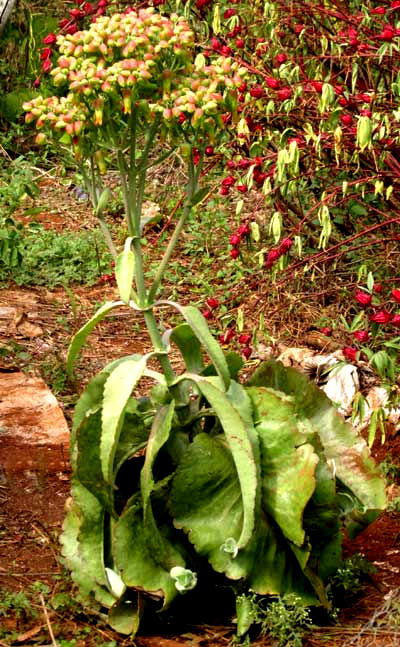
About 20 months ago when I was visiting a friend near Tepotzlán in the arid Mexican highlands south of Mexico City, one of my friend's ornamental plants caught my eye because it was the largest broadleaf succulent I'd ever seen in a pot, with broad leaves two feet or more long (60cm). Along the leaves' scalloped, or "crenate," margins, tiny rosettes of leaves arose at each indentation. It was one of many kinds of "airplant" capable of vegetative reproduction via the leafy rosettes, which can grow into new plants. Similar plantlet-bearing flat leaves on an another airplant species, an invasive sometimes seen in the Yucatan's woods, is shown on our page at www.backyardnature.net/mexnat/airplant.htm
On that page we learn that in this group of plants reproductive rosettes of leaves can occur on the margins of larger leaves because the larger leaves aren't leaves at all. They're "phylloclades," which are highly modified stem branches functioning as and looking like leaves. Vegetative offshoots on a stem make sense, but not on the margin of a real leaf.
The airplant introduced on our earlier airplant page, with phylloclades that were often compound, was different from the one at my friend's house in Tepoztlán. I plucked three aspirin-size buds from one of its phylloclades, put them in my pocket, and carried them to the rancho, where I planted them in pots. After 20 months, you can see one of the resulting belly-high plants at the top of this page.
In that picture, notice the whitish rosettes at tips of the lower phylloclades, and the absence of rosettes from blade margins. This surprised me, because I'd removed my rosettes from phylloclade margins. But then a fallen-off blade that had been cut in two turned up, with rooting rosettes arisen from the margins like my Tepotzlán ones, as shown below:

Maybe, under our hotter, drier Yucatan conditions, phylloclade-tip plantlets arise, while in the cooler, gardener-attended environment at Tepotzlán, margin ones are more likely.
It was the flowers I'd been waiting for mostly, however, needed for me to "do the botany" using my old Bailey's Manual of Cultivated Plants. Bailey's got me as far as the genus Kalanchoeë in the Orpine or Crassula Family, the Crassulaceae, but among the ten species of Kalanchoeë he considers, none was our Tepotzlán plant. On the Internet, after trying various combinations of key words with the Google Image search engine, pictures matching our plants turned up answering to the not-very-technical query "giant Kalanchoeë."
Our Tepotzlán garden plant is KALANCHOË GASTONIS-BONNIERI. Among its English names, Donkey Ears seems to be the most frequently used, along with Life Plant, but that latter name is used for many similar species. Donkey Ears is a native of northwestern Madagascar, but it has escaped from gardens in many tropical countries, and often has become invasive.
The plant's flowers are very distinctive. A close-up view of the flowering head, or inflorescence, is shown below:
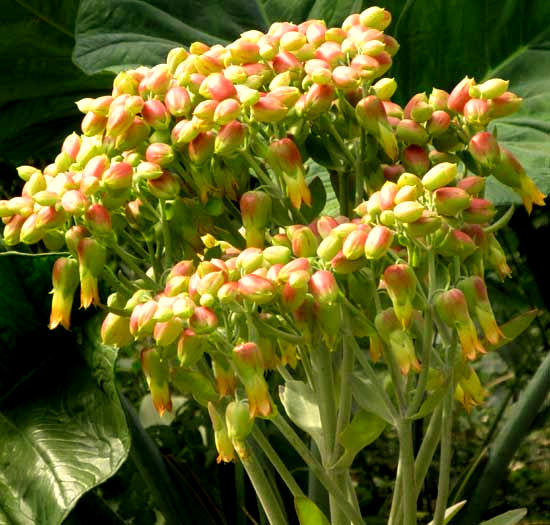
In that picture the yellowish flowers dangle amid pinkish, egg-shaped items. A close-up view of the oval things seen from above the plant is shown below:
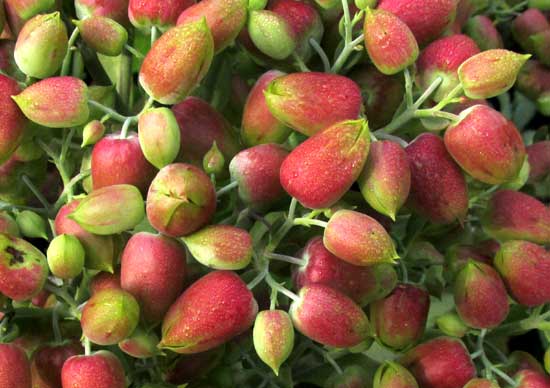
These are "inflated" calyxes. In most flowers the calyx is a green, inconspicuous, cup-like thing below the colored corolla, but inflated calyxes are fairly common in the genus Kalanchoë. Among Bailey's ten species, half produced flowers with inflated calyxes, while calyxes of the other half were only a little or not at all inflated, so the inflated calyx is an important field mark when dealing with the genus Kalanchoë.
For three or four weeks before the first corolla emerged from its inflated calyx, the clusters of bladdery calyxes were just as ornamental as flowering heads, if not more so. When light shined on the calyxes' smooth, somewhat waxy surface, the effect was very striking. Below, you can see a yellowish corolla fully emerged from its subtending calyx:
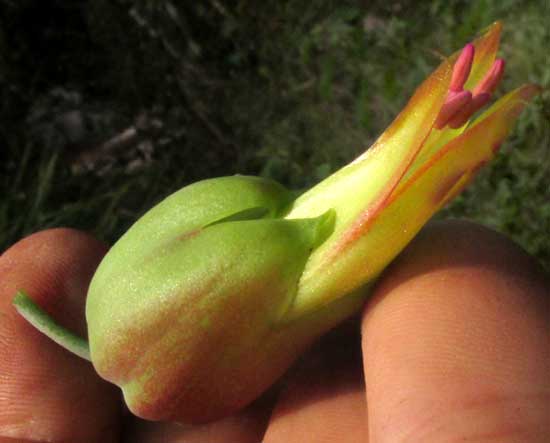
Notice that the corolla is slightly curved. A view from the flower's front shows that it's also flattened, with an upper and lower "lip," seen below:
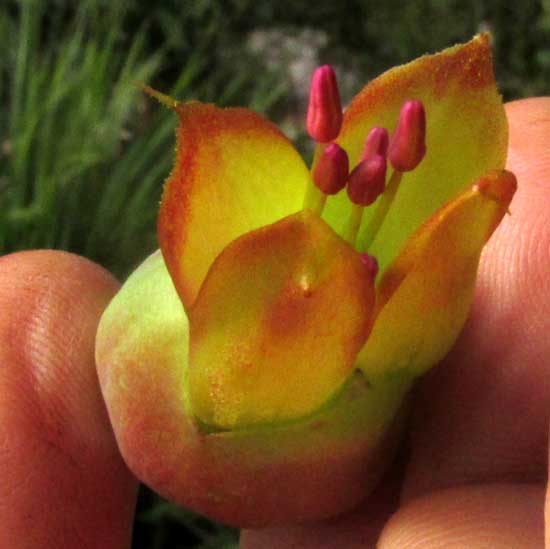
In that picture, the rose-colored, pear-shaped items are pollen-producing anthers atop their slender, yellow filaments. In total, the flower had eight stamens of different lengths, so the other stamens' anthers are hidden inside the corolla.
Among Kalenchoë species with inflated calyxes, the next big feature to notice is whether the corolla is "contracted," or pinched into a narrow waist, at its base. With one side of the calyx removed the answer is obvious, seen below:

This is a classic Kalenchoë contracted corolla base. With the corolla removed, below we can see the flower's four pistils and several of its eight stamens:
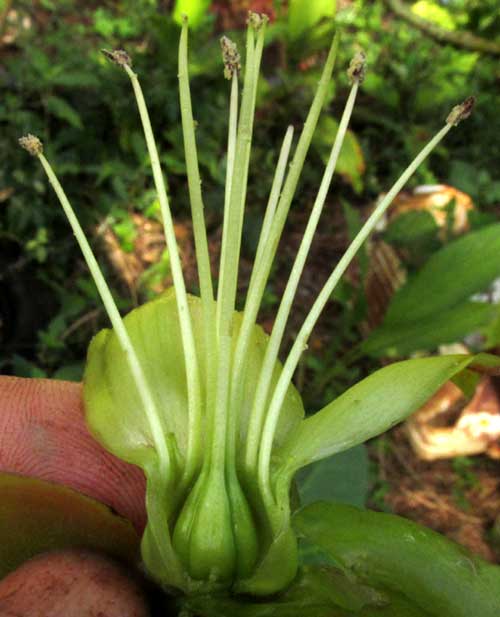
Another important field mark for this particular species is the way the plant's leaflike phylloclades attach to the main stem. The phylloclades' blades connect with the main stem opposite one another, via flat petiole-like parts that expand at their bases to completely encircle the stem with a kind of collar. It's easy to believe that such strange arrangement is something other than regular leaf petioles attaching to a stem. Below, you can see it all:
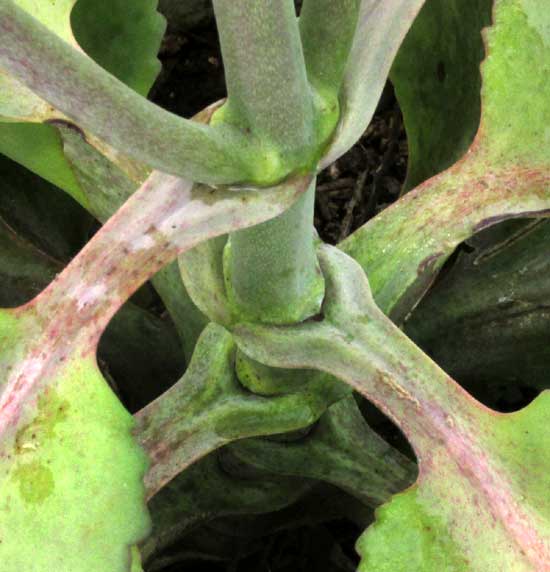
Most pictures of Kalenchoë gastonis-bonnieri show blades conspicuously marked with dark blotches, while our plants display only hints of them. I wonder if these markings develop only on sheltered plants such as those usually grown and photographed by temperate-zone gardeners, while our plants have dealt with nearly two years of tropical heat, sunlight and a hard dry season?
The other Air Plant linked to above we placed in the genus Bryophyllum, not Kalenchoë. In fact, some authors currently call our Tepotzlán plant Bryophyllum gastonis-bonnieri. Many species in this group have been switched back and forth between Kalenchoë and Bryophyllum. I don't know what the best name is, and see no differences between the two genera.